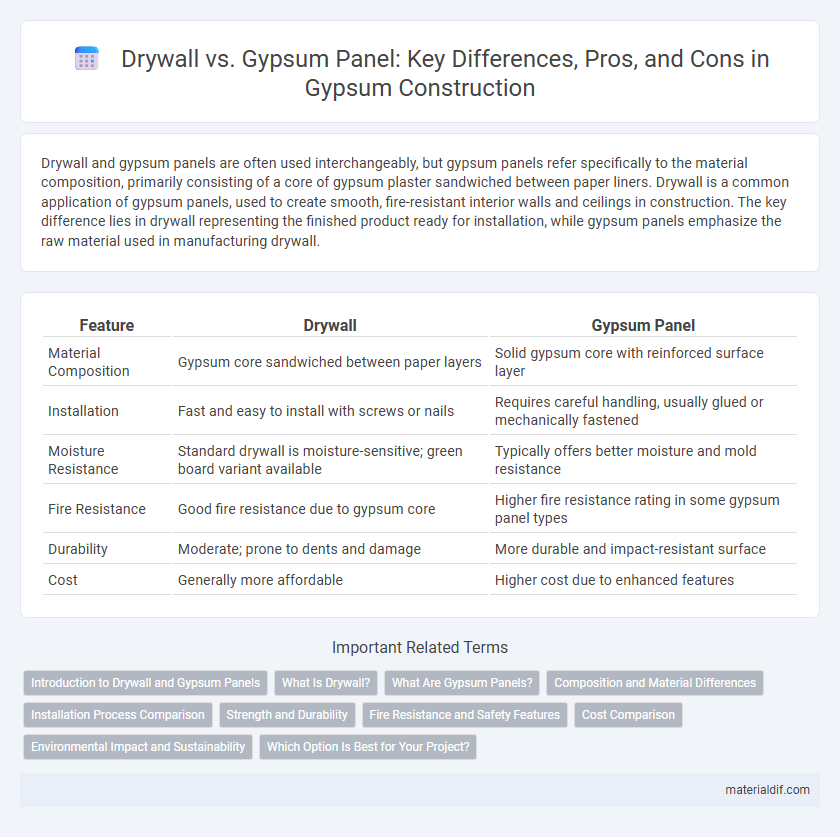Drywall and gypsum panels are often used interchangeably, but gypsum panels refer specifically to the material composition, primarily consisting of a core of gypsum plaster sandwiched between paper liners. Drywall is a common application of gypsum panels, used to create smooth, fire-resistant interior walls and ceilings in construction. The key difference lies in drywall representing the finished product ready for installation, while gypsum panels emphasize the raw material used in manufacturing drywall.
Table of Comparison
| Feature | Drywall | Gypsum Panel |
|---|---|---|
| Material Composition | Gypsum core sandwiched between paper layers | Solid gypsum core with reinforced surface layer |
| Installation | Fast and easy to install with screws or nails | Requires careful handling, usually glued or mechanically fastened |
| Moisture Resistance | Standard drywall is moisture-sensitive; green board variant available | Typically offers better moisture and mold resistance |
| Fire Resistance | Good fire resistance due to gypsum core | Higher fire resistance rating in some gypsum panel types |
| Durability | Moderate; prone to dents and damage | More durable and impact-resistant surface |
| Cost | Generally more affordable | Higher cost due to enhanced features |
Introduction to Drywall and Gypsum Panels
Drywall, also known as gypsum board or plasterboard, consists of a gypsum core sandwiched between two layers of paper, providing a smooth, fire-resistant wall surface. Gypsum panels are a broader category that includes drywall but also specialized panels like moisture-resistant or soundproof variants designed for specific applications. Both materials offer easy installation, cost-effectiveness, and thermal insulation properties essential for modern construction.
What Is Drywall?
Drywall, also known as gypsum board or plasterboard, is a construction material made from a core of gypsum plaster sandwiched between two thick sheets of paper. It is widely used for interior walls and ceilings due to its ease of installation, fire resistance, and smooth finish. Unlike traditional gypsum panels, drywall comes in standardized sizes and thicknesses, offering improved durability and versatility for residential and commercial building projects.
What Are Gypsum Panels?
Gypsum panels are construction materials made from a core of gypsum plaster sandwiched between two layers of paper, offering fire resistance and sound insulation. Unlike traditional drywall, gypsum panels often feature specialized additives for enhanced moisture resistance and structural strength, making them suitable for diverse building applications. These panels provide a durable, lightweight solution for interior wall and ceiling finishes.
Composition and Material Differences
Drywall typically consists of a gypsum plaster core sandwiched between two layers of heavy paper, offering a smooth and easy-to-finish surface, whereas gypsum panels may incorporate fiberglass or other additives to enhance fire resistance and durability. The core composition of drywall is primarily calcium sulfate dihydrate, while specialized gypsum panels often include materials like vermiculite or recycled paper fibers for improved performance. These differences in material composition affect properties such as moisture resistance, flexibility, and strength, making each suitable for specific construction needs.
Installation Process Comparison
Drywall installation involves hanging large panels of gypsum board onto wall studs, securing them with screws or nails, and then applying joint tape and compound to conceal seams and fasteners. Gypsum panels, often pre-finished or enhanced for specific properties like moisture resistance, may require specialized adhesives or fasteners and sometimes need additional surface preparation before installation. Both materials demand skilled labor, but gypsum panels can offer quicker finishing times due to reduced joint treatment compared to traditional drywall.
Strength and Durability
Drywall and gypsum panels both offer reliable wall solutions, but gypsum panels are engineered with higher density and enhanced compressive strength, making them more durable for impact resistance and long-term use. The added fiberglass and resin in gypsum panels improve moisture resistance and reduce susceptibility to cracking compared to standard drywall. Consequently, gypsum panels are preferred in environments that demand superior structural integrity and extended durability.
Fire Resistance and Safety Features
Gypsum panels are inherently fire-resistant due to their core composition of calcium sulfate dihydrate, which releases water vapor when exposed to heat, helping to slow the spread of flames. Drywall, often made with a gypsum core but sometimes varying in quality and additives, provides similar fire resistance but may lack the enhanced safety features found in specialized fire-rated gypsum panels. Fire-rated gypsum panels offer improved safety by meeting stringent building codes and providing greater resistance to heat and smoke penetration compared to standard drywall options.
Cost Comparison
Drywall typically costs between $0.30 to $0.40 per square foot, making it a budget-friendly option for interior wall construction. Gypsum panels, often priced slightly higher at $0.40 to $0.60 per square foot, offer enhanced moisture resistance and durability compared to standard drywall. Project dimension and installation complexity play significant roles in the overall cost difference between drywall and gypsum panel materials.
Environmental Impact and Sustainability
Drywall and gypsum panels both utilize gypsum plaster, a natural mineral, but gypsum panels often incorporate recycled materials and have lower embodied energy, making them more sustainable. Gypsum panel production typically results in reduced carbon emissions compared to traditional drywall manufacturing, contributing to lower environmental impact. Disposal of gypsum panels is also more eco-friendly due to easier recycling processes, supporting circular economy principles in building materials.
Which Option Is Best for Your Project?
Drywall and gypsum panels both provide durable, fire-resistant wall solutions, but drywall is more commonly used for standard interior walls due to its ease of installation and cost-effectiveness. Gypsum panels offer superior moisture resistance and soundproofing, making them ideal for bathrooms, kitchens, and commercial spaces requiring enhanced durability. Choosing between drywall and gypsum panels depends on your project's specific requirements for moisture control, sound insulation, and budget constraints.
Drywall vs Gypsum panel Infographic

 materialdif.com
materialdif.com